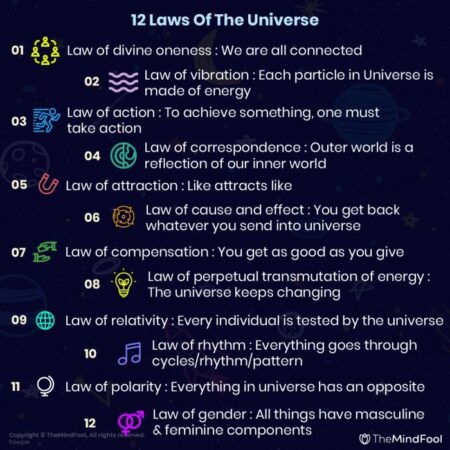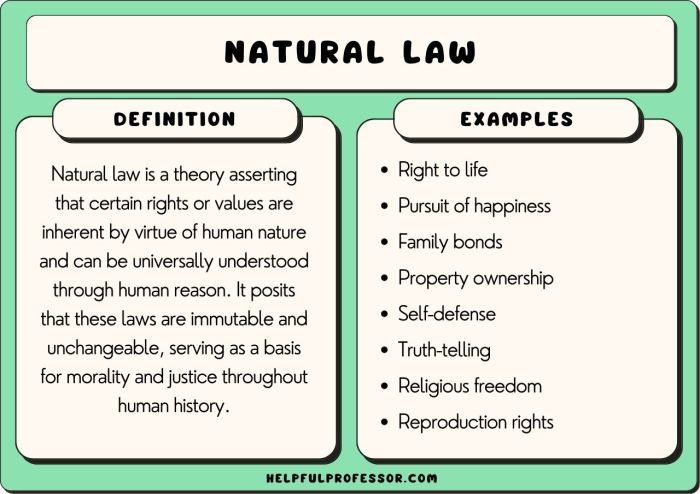
What is the universal law? This question has captivated thinkers for millennia, prompting explorations across diverse fields, from ancient philosophy to modern science. It compels us to examine the fundamental principles that govern the universe, from the laws of physics to the ethical codes that guide our interactions.
The concept of universal law transcends specific disciplines, weaving together threads of philosophy, science, ethics, and law. It seeks to uncover the underlying patterns and principles that connect all things, regardless of time, space, or culture. By delving into this exploration, we can gain a deeper understanding of the world around us and our place within it.
Philosophical Perspectives on Universal Law

The concept of universal law, encompassing principles and rules that apply to all beings, has been a central theme in philosophical discourse throughout history. From ancient Greek thinkers to modern philosophers, the search for universal truths and their implications for morality, justice, and the nature of reality has been a constant pursuit. Examining the evolution of this concept reveals diverse philosophical schools of thought and their interpretations of universal law.
The Historical Development of Universal Law
The idea of universal law can be traced back to ancient Greek philosophers like Socrates, Plato, and Aristotle. Socrates emphasized the importance of living a virtuous life guided by reason and universal principles. Plato, in his theory of Forms, proposed the existence of eternal and unchanging ideals, including justice, beauty, and truth, which served as models for the world. Aristotle, in his work on ethics and politics, explored the concept of natural law, arguing that there are inherent principles of morality and justice that are discoverable through reason and observation.
Natural Law
Natural law theory, rooted in the belief that moral principles are inherent in the natural order, has profoundly influenced the concept of universal law. This school of thought, prominent in the Middle Ages and Renaissance, holds that universal laws are grounded in nature, reason, or God’s will. Notable proponents of natural law include Thomas Aquinas, who argued that natural law is derived from divine law and is accessible through human reason.
Positivism
In contrast to natural law, positivism, a philosophical approach that emerged in the 19th century, rejects the notion of universal laws based on inherent principles. Positivists, such as Jeremy Bentham and John Austin, emphasize the importance of positive law, which is the law created by human beings. They argue that universal law is a matter of social convention and legal authority, not inherent truths.
Utilitarianism
Utilitarianism, a moral philosophy associated with thinkers like Jeremy Bentham and John Stuart Mill, focuses on maximizing happiness and well-being for the greatest number of people. While not explicitly advocating for universal law, utilitarianism suggests that principles aimed at promoting overall happiness could be considered universal, as they apply to all individuals.
Universal Law in Different Religions and Belief Systems
The concept of universal law finds expression in various religions and belief systems. In Christianity, the Ten Commandments are often interpreted as universal moral principles, while in Islam, the Sharia law is a comprehensive system of Islamic law based on the Quran and Sunnah. Buddhism emphasizes the Four Noble Truths and the Eightfold Path as universal principles for attaining enlightenment.
Comparing and Contrasting Approaches to Universal Law
Different philosophical schools and belief systems offer diverse perspectives on universal law. Natural law emphasizes inherent principles grounded in nature, reason, or divine will, while positivism focuses on positive law created by human beings. Utilitarianism prioritizes principles that promote happiness and well-being for the greatest number. Religious and belief systems often incorporate universal laws within their teachings and practices.
Universal Laws in Science

Universal laws in science are fundamental principles that govern the behavior of the natural world. These laws are based on extensive observations and experiments, and they have been repeatedly verified over time. They are considered to be universal because they apply to all phenomena within their scope, regardless of location, time, or other factors.
Examples of Universal Laws in Science
Universal laws are found in various branches of science, including physics, chemistry, and biology. Here are some prominent examples:
- Physics:
- Newton’s Laws of Motion: These laws describe the relationship between force, mass, and acceleration. They are fundamental to understanding the motion of objects in the universe, from the movement of planets to the trajectory of a thrown ball.
- Law of Universal Gravitation: This law states that every particle in the universe attracts every other particle with a force that is proportional to the product of their masses and inversely proportional to the square of the distance between their centers. This law explains the gravitational attraction between celestial bodies, such as the Earth and the Moon.
- Laws of Thermodynamics: These laws govern the relationship between heat, work, and energy. They are essential for understanding energy transformations and the efficiency of engines and other machines.
- Chemistry:
- Law of Conservation of Mass: This law states that the total mass of a closed system remains constant over time, even if chemical reactions occur within the system. This law is fundamental to understanding chemical reactions and the balance of matter in the universe.
- Law of Definite Proportions: This law states that a chemical compound always contains the same elements in the same proportions by mass, regardless of its source or method of preparation. This law is crucial for understanding the composition and properties of chemical compounds.
- Law of Multiple Proportions: This law states that when two elements combine to form more than one compound, the masses of one element that combine with a fixed mass of the other element are in ratios of small whole numbers. This law helps to explain the existence of different chemical compounds formed by the same elements.
- Biology:
- Cell Theory: This theory states that all living organisms are composed of cells and that all cells arise from pre-existing cells. This theory is a fundamental principle of biology, explaining the basic unit of life and its origin.
- Theory of Evolution by Natural Selection: This theory explains the diversity of life on Earth through the process of natural selection, where organisms with advantageous traits are more likely to survive and reproduce. This theory has revolutionized our understanding of the history and development of life.
- Central Dogma of Molecular Biology: This theory describes the flow of genetic information from DNA to RNA to protein. This dogma is fundamental to understanding the mechanisms of gene expression and protein synthesis in all living organisms.
Characteristics of Universal Laws
Universal laws in science share several characteristics:
- Applicability across different contexts: They apply to all phenomena within their scope, regardless of location, time, or other factors. For example, Newton’s Laws of Motion apply to objects on Earth, in space, or on other planets.
- Consistency over time: They have been repeatedly verified over time and have not been contradicted by new discoveries. For example, the Law of Conservation of Mass has been consistently upheld by countless experiments and observations.
- Predictive power: They allow us to predict the behavior of natural phenomena. For example, the Law of Universal Gravitation allows us to predict the orbits of planets and other celestial bodies.
- Mathematical expression: They can often be expressed mathematically, which provides a precise and quantitative description of the relationship between different variables. For example, Newton’s Laws of Motion can be expressed as mathematical equations.
Limitations of Scientific Laws
While scientific laws are considered to be universal, they are not absolute truths. They are based on our current understanding of the natural world, and they can be revised or overturned by new discoveries.
- Scope of applicability: Laws may have limitations in their scope of applicability. For example, Newton’s Laws of Motion break down at very high speeds or in very strong gravitational fields, where Einstein’s theory of relativity is required.
- Emergent properties: Complex systems can exhibit emergent properties that are not predicted by the laws governing their individual components. For example, the behavior of a flock of birds cannot be fully explained by the laws of motion governing individual birds.
- Incomplete knowledge: Our understanding of the natural world is constantly evolving, and new discoveries may lead to revisions or even overturning of existing laws. For example, the discovery of quantum mechanics led to a revision of our understanding of classical physics.
Universal Principles in Ethics and Morality: What Is The Universal Law
The concept of universal principles in ethics and morality explores the fundamental values and guidelines that are considered applicable across diverse cultures and societies. These principles aim to provide a framework for ethical decision-making and behavior, promoting fairness, respect, and well-being for all.
Core Ethical Principles
Universal ethical principles serve as foundational pillars for moral reasoning and action. Some of the most widely recognized principles include:
- Justice: This principle emphasizes fairness and impartiality in the distribution of benefits and burdens. It calls for equal treatment of individuals under the law and equitable access to resources and opportunities. Justice also involves holding individuals accountable for their actions and ensuring that wrongs are rectified.
- Fairness: Fairness is closely related to justice, but it also encompasses the idea of treating people in a way that is reasonable and just, even if it means deviating from strict equality. Fairness requires considering individual circumstances and needs, and ensuring that decisions are made without bias or prejudice.
- Respect for Human Dignity: This principle recognizes the inherent worth and value of every individual, regardless of their background, beliefs, or circumstances. It calls for treating all people with respect and consideration, and refraining from actions that violate their autonomy, privacy, or bodily integrity.
- Beneficence: This principle emphasizes the duty to act in a way that benefits others. It encourages individuals to promote the well-being of others and to take actions that alleviate suffering and improve their lives.
- Non-maleficence: This principle requires individuals to avoid causing harm to others. It emphasizes the importance of taking precautions to prevent harm, and the need to act with care and consideration for the potential consequences of one’s actions.
Challenges of Applying Universal Ethical Principles
While these principles are widely accepted as universal, applying them in diverse cultural contexts can present significant challenges. Different cultures have varying values, beliefs, and traditions that may influence their interpretation and application of these principles. For instance, what constitutes “fairness” or “respect” may differ across cultures.
- Cultural Relativism: This perspective argues that ethical principles are relative to a particular culture and that there are no universal moral standards. Cultural relativists argue that judging other cultures based on one’s own ethical framework is ethnocentric and inappropriate.
- Universalism vs. Relativism: The debate between universalism and relativism in ethics is ongoing. Universalists believe that there are universal ethical principles that apply to all cultures, while relativists argue that morality is relative to each culture. Finding a balance between respecting cultural differences and upholding universal ethical principles is a key challenge.
Examples of Application and Violation
- The Nuremberg Trials (1945-1949): These trials, which followed World War II, demonstrated the application of universal ethical principles in response to atrocities committed by the Nazi regime. The trials established the principle of individual responsibility for crimes against humanity, regardless of orders received, and recognized the inherent dignity of all individuals.
- The Universal Declaration of Human Rights (1948): This document, adopted by the United Nations, Artikels fundamental human rights that are considered universal and inalienable. It serves as a global standard for protecting human dignity and promoting justice and equality for all.
- The Rwandan Genocide (1994): This horrific event, in which hundreds of thousands of Tutsis were killed, demonstrated the devastating consequences of the violation of universal ethical principles, particularly respect for human dignity and non-maleficence. The genocide was fueled by hatred, prejudice, and the disregard for the fundamental rights of others.
Universal Laws in Society and Law
The concept of universal laws extends beyond the realms of science and philosophy, influencing the very fabric of human societies and legal systems. From the ancient principles of natural law to the modern framework of international law, the pursuit of universal standards has shaped the way we govern ourselves and interact with one another. This section delves into the intricate relationship between universal laws and the legal structures that govern our world.
Natural Law and its Influence on Legal Systems
Natural law, a philosophical concept that posits the existence of inherent moral principles governing human conduct, has profoundly influenced legal systems throughout history. It suggests that certain rights and obligations are inherent to human beings, independent of any particular legal system or cultural norms. This concept has been central to the development of legal systems in various civilizations, including ancient Greece, Rome, and the Western world.
Natural law has served as a foundation for numerous legal principles, including the right to life, liberty, and property, which are often enshrined in constitutions and legal codes. For instance, the Declaration of Independence, a foundational document of the United States, explicitly invokes natural law principles, stating that all men are endowed with certain unalienable rights, including “Life, Liberty and the pursuit of Happiness.” This influence can also be seen in the Universal Declaration of Human Rights, which draws upon natural law principles to articulate fundamental human rights applicable to all individuals.
The Role of International Law in Establishing Universal Standards
International law, a complex system of rules and principles governing the relations between states, plays a crucial role in establishing universal standards across diverse legal systems. It aims to create a framework for peaceful coexistence, cooperation, and the protection of shared interests. This framework extends to various domains, including human rights, environmental protection, and international trade.
International law relies on a combination of treaties, conventions, customary law, and judicial decisions to establish universal norms. Treaties, which are formal agreements between states, serve as binding legal instruments that codify specific rules and principles. Conventions, similar to treaties, establish international standards and norms in particular areas. For instance, the Geneva Conventions, a series of treaties, Artikel rules governing the treatment of prisoners of war and civilians during armed conflicts. The International Covenant on Civil and Political Rights (ICCPR) and the International Covenant on Economic, Social and Cultural Rights (ICESCR) are examples of conventions that establish universal human rights standards.
Examples of Universal Legal Principles Codified in International Treaties and Conventions, What is the universal law
International treaties and conventions provide numerous examples of universal legal principles codified into binding international law. These principles reflect shared values and aspirations of the international community.
- Human Rights: The Universal Declaration of Human Rights (UDHR), adopted by the United Nations General Assembly in 1948, is a cornerstone of international human rights law. It establishes fundamental rights and freedoms for all individuals, including the right to life, liberty, and security of person; freedom from torture and slavery; and the right to freedom of expression and assembly. These principles have been further elaborated in subsequent treaties, such as the ICCPR and ICESCR, which have been ratified by a vast majority of countries.
- Environmental Protection: The international community has recognized the importance of environmental protection and has established numerous treaties and conventions to address shared environmental concerns. The United Nations Framework Convention on Climate Change (UNFCCC), for instance, aims to stabilize greenhouse gas concentrations in the atmosphere to prevent dangerous anthropogenic interference with the climate system. The Convention on International Trade in Endangered Species of Wild Flora and Fauna (CITES) regulates the international trade of endangered species to protect biodiversity.
- International Trade: The World Trade Organization (WTO) provides a framework for regulating international trade. The WTO agreements, negotiated and signed by the countries that account for the vast majority of global trade, aim to ensure that trade flows smoothly, predictably, and freely. The WTO’s rules are designed to help producers, exporters, and importers conduct their business with clear expectations of the trade policies they will encounter.
Universal Laws in Art and Culture

Art and culture, in their diverse forms, often reflect and express universal laws and principles that transcend time and cultural boundaries. From the harmonious proportions found in ancient architecture to the recurring themes of love, loss, and the search for meaning in literature and music, these universal laws serve as a common language that connects individuals across cultures and generations.
Universal Themes and Motifs in Art
Universal themes and motifs are recurring ideas, symbols, and patterns that appear across various cultures and artistic expressions. These themes often reflect fundamental human experiences, emotions, and aspirations. Here is a table showcasing some examples:
| Theme/Motif | Examples | Cultures | Time Periods |
|---|---|---|---|
| Love and Romance | Romeo and Juliet (Shakespeare), The Love Song of J. Alfred Prufrock (T.S. Eliot), La Traviata (Verdi) | Western, Eastern | Ancient to Modern |
| Loss and Grief | The Odyssey (Homer), The Great Gatsby (F. Scott Fitzgerald), Requiem for a Dream (Darren Aronofsky) | Western, Eastern | Ancient to Modern |
| The Search for Meaning | The Book of Job (Bible), The Myth of Sisyphus (Albert Camus), The Lord of the Rings (J.R.R. Tolkien) | Western, Eastern | Ancient to Modern |
| Nature and the Cosmos | The Starry Night (Van Gogh), The Rite of Spring (Stravinsky), The Tao Te Ching (Lao Tzu) | Western, Eastern | Ancient to Modern |
| The Hero’s Journey | The Epic of Gilgamesh, The Iliad (Homer), Star Wars (George Lucas) | Western, Eastern | Ancient to Modern |
Universal Laws and Principles in Artistic Expressions
Universal laws and principles are often embedded in artistic expressions, shaping their aesthetic qualities and conveying deeper meanings.
The Golden Ratio
The golden ratio, approximately 1.618, is a mathematical principle that appears in nature and has been used by artists and architects throughout history to create aesthetically pleasing proportions. This ratio is often found in the proportions of human bodies, the arrangement of leaves on a stem, and the spiral patterns of seashells. In art, the golden ratio is often used to create a sense of balance, harmony, and visual appeal. Examples include:
* The Parthenon in Athens, Greece, where the golden ratio is found in the proportions of the building’s facade.
* The Mona Lisa by Leonardo da Vinci, where the golden ratio is present in the arrangement of the figure’s face and body.
* The spiral patterns in the paintings of Vincent van Gogh, such as The Starry Night, which reflect the golden ratio in their proportions.
The Concept of Beauty
Beauty is a subjective concept, but certain principles of beauty are often considered universal. These principles include:
* Symmetry: Symmetrical forms are often perceived as aesthetically pleasing, as they suggest balance and harmony. Examples include the human face, the wings of a butterfly, and the architecture of ancient temples.
* Proportion: The harmonious relationship between different parts of a composition is essential for beauty. This principle is reflected in the golden ratio, as well as in the use of perspective in painting.
* Color Harmony: The combination of colors that create a pleasing and balanced visual experience is a key aspect of beauty. Complementary colors, such as blue and orange, or red and green, often create a sense of visual excitement, while analogous colors, such as blue and green, create a more calming effect.
The Search for Meaning
Art often serves as a vehicle for exploring the meaning of life and our place in the universe. This search for meaning can be expressed through various themes and motifs, such as:
* The human condition: Art often explores themes of love, loss, hope, despair, and the struggle for meaning in the face of suffering. Examples include Shakespeare’s tragedies, Tolstoy’s War and Peace, and the paintings of Edvard Munch.
* The spiritual realm: Art can express spiritual beliefs, values, and experiences. Examples include religious art, such as icons and murals, and the music of Bach and Mozart.
* The natural world: Art can reflect our awe and wonder at the beauty and complexity of the natural world. Examples include landscape paintings, nature photography, and the music of Vivaldi.
Cultural Differences in the Interpretation and Application of Universal Laws
While universal laws and principles are often reflected in artistic expressions across cultures, cultural differences can shape their interpretation and application.
* Aesthetic Preferences: Different cultures have different aesthetic preferences, which can influence the way they perceive and appreciate art. For example, the preference for bold colors and intricate patterns in Islamic art contrasts with the minimalist aesthetic of Japanese art.
* Religious Beliefs: Religious beliefs can influence the subject matter, style, and symbolism of art. For example, Christian art often features religious figures and scenes from the Bible, while Buddhist art often depicts deities and scenes from Buddhist mythology.
* Social Values: Social values and norms can also influence the way art is created and interpreted. For example, the portrayal of the human body in art can vary greatly depending on cultural norms.
Last Point
The quest to define universal law is an ongoing journey, one that invites us to engage in critical thinking, open dialogue, and a constant search for meaning. While there may not be one definitive answer, the pursuit itself offers invaluable insights into the nature of existence, the complexities of human experience, and the potential for a more harmonious and just world.
Detailed FAQs
What are some examples of universal laws in science?
Examples include the laws of motion, gravity, and thermodynamics. These laws apply across various contexts and time periods, demonstrating their universal nature.
How can universal laws be applied in everyday life?
Understanding universal laws can help us make ethical decisions, navigate complex social situations, and appreciate the interconnectedness of all things.
What are some challenges to the concept of universal law?
Challenges include the difficulty of defining universality across diverse cultures and perspectives, the potential for bias in interpretations, and the ongoing evolution of knowledge and understanding.

